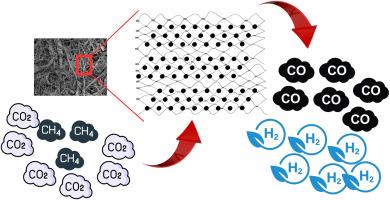二氧化硅纳米纤维负载的高稳定镍基催化剂用于富二氧化碳原料甲烷干重整
IF 6.2
2区 工程技术
Q2 ENERGY & FUELS
引用次数: 0
摘要
氢气生产是实现低碳社会的关键因素。甲烷干重整是支持氢经济的一项有前途的技术,而催化剂的开发是提高干重整反应效率的关键。本研究在固定床反应器中研究了两种不同的Ni - ce复合材料对二氧化硅纤维(NiCe/SF)和Ni催化剂对SiO2-CeO2复合纤维的催化性能,并在进料中研究了两种不同的CO2:CH4比例(50:50和85:15)。在CeO2的作用下,催化剂表面出现了分散良好的金属团簇。程序升温还原氢分析表明,CeO2的存在增加了合成体系中金属-载体相互作用。所有样品的CH4转化率均为80%。镍基催化剂在SF上的H2/CO比为~ 1.2,接近费托反应的H2/CO要求。10% Ni/Ce-SF催化剂在50 h以上的反应条件下表现出良好的稳定性,可重复使用3次以上;废催化剂上仅观察到4.5%的结焦。本研究结果证实了SF上ni基催化剂在DRM中表现出良好的催化活性,为设计和开发可持续制氢策略的研究开辟了道路。本文章由计算机程序翻译,如有差异,请以英文原文为准。

Highly stable Ni-based catalysts supported on silica nanofibers for the dry reforming of methane with CO2-rich feedstock
Hydrogen production is a critical factor in implementing low-carbon societies. The dry reforming of methane (DRM) is a promising technology for supporting the hydrogen economy, and catalyst development is vital for enhancing the efficiency of dry reforming reactions. In this study, the catalytic performances of two different Ni–Ce composites over silica fiber (NiCe/SF) and a Ni catalyst over SiO2–CeO2 composite fibers were studied in the DRM with a fixed-bed reactor and two different CO2:CH4 ratios in the feed (50:50 and 85:15). Well-dispersed metal clusters were observed on the surface of the catalysts owing to the effect of CeO2. Temperature-programmed reduction of hydrogen analysis indicated that the presence of CeO2 increased metal–support interactions in the synthesized systems. All samples showed a CH4 conversion of >80 %. The Ni-based catalysts on SF showed an H2/CO ratio of ∼1.2, approaching the H2/CO requirement of the Fischer–Tropsch reaction. The 10 %Ni/Ce-SF catalyst exhibited good stability under the reaction conditions for over 50 h and could be reused for up to three cycles; only 4.5 % coking was observed on the spent catalyst. The results of this study confirm that Ni-based catalysts on SF show good catalytic activity in the DRM, opening the way for research on the design and development of sustainable hydrogen production strategies.
求助全文
通过发布文献求助,成功后即可免费获取论文全文。
去求助
来源期刊

Journal of The Energy Institute
工程技术-能源与燃料
CiteScore
10.60
自引率
5.30%
发文量
166
审稿时长
16 days
期刊介绍:
The Journal of the Energy Institute provides peer reviewed coverage of original high quality research on energy, engineering and technology.The coverage is broad and the main areas of interest include:
Combustion engineering and associated technologies; process heating; power generation; engines and propulsion; emissions and environmental pollution control; clean coal technologies; carbon abatement technologies
Emissions and environmental pollution control; safety and hazards;
Clean coal technologies; carbon abatement technologies, including carbon capture and storage, CCS;
Petroleum engineering and fuel quality, including storage and transport
Alternative energy sources; biomass utilisation and biomass conversion technologies; energy from waste, incineration and recycling
Energy conversion, energy recovery and energy efficiency; space heating, fuel cells, heat pumps and cooling systems
Energy storage
The journal''s coverage reflects changes in energy technology that result from the transition to more efficient energy production and end use together with reduced carbon emission.
 求助内容:
求助内容: 应助结果提醒方式:
应助结果提醒方式:


